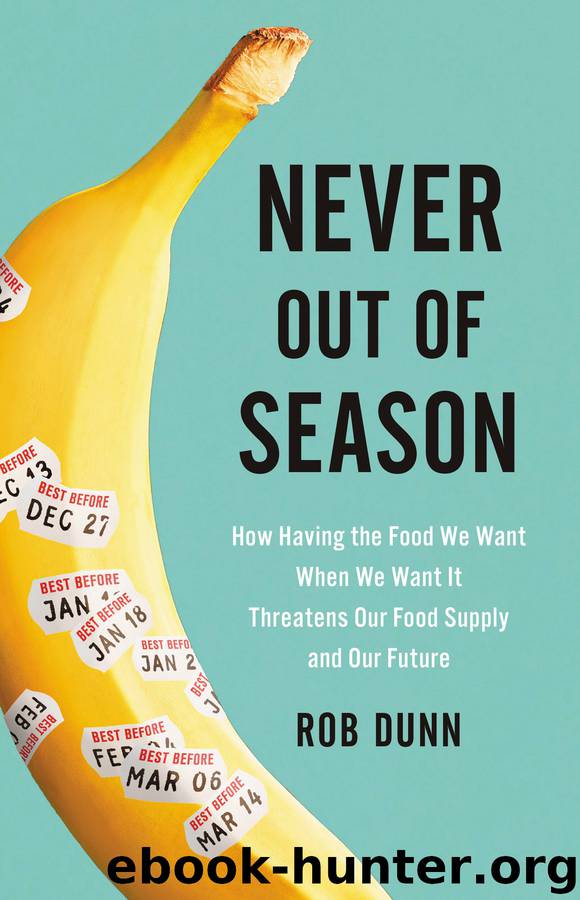Never Out of Season by Rob Dunn

Author:Rob Dunn [DUNN, ROB]
Language: eng
Format: epub, pdf
Tags: Nature / Natural Resources, Science / Environmental Science (See Also Chemistry / Environmental), Science / Life Sciences / Biological Diversity, Science / Life Sciences / Horticulture
Publisher: Little, Brown and Company
Published: 2017-03-14T00:00:00+00:00
Superficially, agriculture, including the farming of rubber trees, is often in conflict with wild nature. Ford cut down forests to make Fordlandia and Belterra. Similarly, the soybean fields of Brazil compete for space with the rain forests they replace. Any land being farmed is land that is not being conserved. Some kinds of agriculture are less in conflict with nature than are others, but none is without consequences, not now that humans number in the billions. Nor do the effects of agriculture on wild nature end at the edges of farms. The agriculture of the Green Revolution often leads to pollution—from pesticides, fertilizers, and herbicides—conferring negative effects that have a broad reach. Yet the sustainability of agriculture, our ability to keep farming beyond the next fifty, hundred, or even thousand years, depends upon the very forests threatened by farms. We need enough land in farms so that we can continue to eat (or, in the case of rubber, drive) in the short term, but not so much that it threatens our ability to eat in the long term. Although we don’t treat it as such, nature is still the ultimate reservoir of our agricultural ingenuity.
The value of wild nature to agriculture is that it acts as a buffer for our ignorance. Sometimes we do a poor job of managing our crops, or evolution surprises us, and when this happens we turn to wild nature for solutions. In the context of rubber, because no traditional varieties of domesticated rubber trees exist, our dependence on wild nature is direct, mediated only by scientific knowledge and the traditional knowledge of indigenous Amazonians about rubber plants. We will need wild nature regardless of the severity of the problem. In the case of other crops, the dependence on wild nature emerges in the context of new extremes, whether of pests, pathogens, or climates. Sometimes the traditional varieties of crops are simply not varied enough to solve all our problems.
Sometimes agriculture benefits from wild nature through chance and sex. Liaisons between crops and their wild relatives move novel genes into agriculture. Nearly all such unions yield seeds and plants that are less useful than were their domesticated parents, but every so often a seed produced through such an exchange will have a new, useful combination of traits. Farmers have long benefited from the value of wild relatives of crops to their seeds. Traditional farmers in the highlands of Mexico, for example, are said to plant their corn crops near teosinte in order to infuse the corn with new traits, particularly when it faces new weather patterns or pests.6 We can detect the history of such flow in the genes of our crops. We know from the genes of domesticated grapes that as farmers moved grapes west through Europe, their grapes bred with wild grapes. Rather than tossing the resulting fruits out, farmers planted them. We have Pinot Noir and Traminer as a result.7
Pollen can move from teosinte to corn in the wind. Grapes require insects to carry their pollen from flower to flower.
Download
This site does not store any files on its server. We only index and link to content provided by other sites. Please contact the content providers to delete copyright contents if any and email us, we'll remove relevant links or contents immediately.
Man-made Catastrophes and Risk Information Concealment by Dmitry Chernov & Didier Sornette(4750)
The Revenge of Geography: What the Map Tells Us About Coming Conflicts and the Battle Against Fate by Kaplan Robert D(3602)
Zero Waste Home by Bea Johnson(3297)
COSMOS by Carl Sagan(2961)
In a Sunburned Country by Bill Bryson(2953)
Good by S. Walden(2921)
The Fate of Rome: Climate, Disease, and the End of an Empire (The Princeton History of the Ancient World) by Kyle Harper(2444)
Camino Island by John Grisham(2392)
A Wilder Time by William E. Glassley(2367)
Organic Mushroom Farming and Mycoremediation by Tradd Cotter(2314)
Human Dynamics Research in Smart and Connected Communities by Shih-Lung Shaw & Daniel Sui(2181)
The Ogre by Doug Scott(2121)
Energy Myths and Realities by Vaclav Smil(2068)
The Traveler's Gift by Andy Andrews(2017)
Inside the Middle East by Avi Melamed(1946)
Birds of New Guinea by Pratt Thane K.; Beehler Bruce M.; Anderton John C(1915)
Ultimate Navigation Manual by Lyle Brotherton(1770)
A History of Warfare by John Keegan(1723)
And the Band Played On by Randy Shilts(1622)
